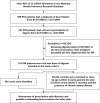Risk of digoxin intoxication in heart failure patients exposed to digoxin-diuretic interactions: a population-based study
- PMID: 20653679
- PMCID: PMC2911556
- DOI: 10.1111/j.1365-2125.2010.03687.x
Risk of digoxin intoxication in heart failure patients exposed to digoxin-diuretic interactions: a population-based study
Abstract
WHAT IS ALREADY KNOWN ABOUT THIS SUBJECT * Increased frequency of electrolyte abnormalities and cardiac arrhythmias among patients exposed to digoxin-diuretic interactions has been well-documented in numerous descriptive studies. * Nonetheless, a clear causal relationship has not been established in these studies. WHAT THIS STUDY ADDS * The risks of digoxin intoxication associated with use of digoxin in combination with any diuretic use, types of diuretics, combinations of diuretics, and individual diuretics were quantified using a population-based nested case-control study design. * The combined therapy of digoxin with any diuretic is associated with a 3.08-fold increase in the risk of digoxin intoxication. * Regarding diuretic class, the risk carried by loop diuretics is greater than that of thiazides or potassium-sparing diuretics, and the risk varies with different combinations of diuretic classes and individual diuretics. AIMS To quantify the digoxin intoxication risk associated with exposure to digoxin-diuretic interactions, and evaluate whether the risk varies by diuretic type, individually or in combination. METHODS This was a population-based nested case-control study in which data from the National Health Insurance Research Database (NHIRD) in Taiwan were analysed. RESULTS The study cohort comprised 154 058 heart failure (HF) patients taking digoxin between 2001 and 2004, in whom digoxin intoxication requiring a hospitalization (ICD-9 code 972.1) occurred in 595 cases. A total of 28 243 matched controls were also selected for analysis. Cases were 3.08 times (adjusted OR 3.08, 95% CI 2.50, 3.79) more likely to have been prescribed diuretic medication in the previous month than controls. Regarding the class of diuretics, loop diuretics carried the greatest risk (adjusted OR 2.97, 95% CI 2.35, 3.75), followed by thiazides (OR 2.36, 95% CI 1.70, 3.29) and potassium-sparing diuretics (OR 1.72, 95% CI 0.83, 3.56). The risk was also observed to vary with different combinations of diuretics, and the loops/thiazides/potassium-sparing diuretics combination carried the greatest risk (adjusted OR 6.85, 95% CI 4.93, 9.53). Among the individual diuretics examined, hydrochlorothiazide carried the greatest risk (adjusted OR 4.63, 95% CI 2.50, 8.57). CONCLUSIONS This study provided empirical evidence that digoxin-diuretic interactions increased the risk of hospitalization for digoxin intoxication in HF patients. The risk was particularly high for concomitant use of digoxin with a combination of loop diuretics, thiazide and potassium-sparing diuretics. The combined use of digoxin and diuretics should be avoided if possible.
Figures
Similar articles
-
Risk of digoxin intoxication caused by clarithromycin-digoxin interactions in heart failure patients: a population-based study.Eur J Clin Pharmacol. 2009 Dec;65(12):1237-43. doi: 10.1007/s00228-009-0698-4. Eur J Clin Pharmacol. 2009. PMID: 19655133
-
Heart failure, chronic diuretic use, and increase in mortality and hospitalization: an observational study using propensity score methods.Eur Heart J. 2006 Jun;27(12):1431-9. doi: 10.1093/eurheartj/ehi890. Epub 2006 May 18. Eur Heart J. 2006. PMID: 16709595 Free PMC article.
-
Chronic heart failure and risk of hospitalization with pneumonia: a population-based study.Eur J Intern Med. 2013 Jun;24(4):349-53. doi: 10.1016/j.ejim.2013.02.013. Epub 2013 Mar 17. Eur J Intern Med. 2013. PMID: 23510659
-
[Value of aldosterone receptor blockade in diuretic therapy of patients with chronic heart failure].Herz. 2002 Mar;27(2):135-49. doi: 10.1007/s00059-002-2352-0. Herz. 2002. PMID: 12025459 Review. German.
-
The pathophysiology and management of diuretic resistance in patients with heart failure.Hosp Pract (1995). 2022 Apr;50(2):93-101. doi: 10.1080/21548331.2021.1893065. Epub 2021 Apr 12. Hosp Pract (1995). 2022. PMID: 33596757 Review.
Cited by
-
Chronic Digoxin Toxicity Leading to Institutionalization of an Elderly Woman.Can J Hosp Pharm. 2022 Spring;75(2):118-121. doi: 10.4212/cjhp.v75i2.3069. Epub 2022 Apr 4. Can J Hosp Pharm. 2022. PMID: 35387367 Free PMC article. No abstract available.
-
Retrospective Analysis of Potential Adverse Drug Interactions in the Drugs Prescribed to the Elderly at a Tertiary Health Care Center in Raipur, Chhattisgarh, Central India.Cureus. 2024 Feb 7;16(2):e53767. doi: 10.7759/cureus.53767. eCollection 2024 Feb. Cureus. 2024. PMID: 38465112 Free PMC article.
-
Bidirectional ventricular tachycardia due to digoxin-diuretic interaction in post-cardiac surgery patient: a case report.Arch Peru Cardiol Cir Cardiovasc. 2024 Jun 24;5(2):e362. doi: 10.47487/apcyccv.v5i2.362. eCollection 2024 Apr-Jun. Arch Peru Cardiol Cir Cardiovasc. 2024. PMID: 39015194 Free PMC article.
-
Prevalence and differences in the co-administration of drugs known to interact: an analysis of three distinct and large populations.BMC Med. 2024 Apr 19;22(1):166. doi: 10.1186/s12916-024-03384-1. BMC Med. 2024. PMID: 38637816 Free PMC article.
-
Association between Sedative-hypnotics and Subsequent Cancer in Patients with and without Insomnia: A 14-year Follow-up Study in Taiwan.J Cancer. 2019 May 21;10(10):2288-2298. doi: 10.7150/jca.30680. eCollection 2019. J Cancer. 2019. PMID: 31258732 Free PMC article.
References
-
- Janchawee B, Wongpoowarak W, Owatranporn T, Chongsuvivatwong V. Pharmacoepidemiologic study of potential drug interactions in outpatients of a university hospital in Thailand. J Clin Pharm Ther. 2005;30:13–20. - PubMed
-
- Magro L, Conforti A, Del Zotti F, Leone R, Iorio ML, Meneghelli I, Massignani D, Visonà E, Moretti U. Identification of severe potential drug-drug interactions using an Italian general-practitioner database. Eur J Clin Pharmacol. 2008;64:303–9. - PubMed
-
- Bennett S. Diuretics: use, actions and prescribing rationale. Nurse Prescribing. 2008;6:72–7.
-
- Jessup M, Abraham WT, Casey DE, Feldman AM, Francis GS, Ganiats TG, Konstam MA, Mancini DM, Rahko PS, Silver MA, Stevenson LW, Yancy CW. 2009 Focused update: ACCF/AHA Guidelines for the Diagnosis and Management of Heart Failure in Adults: a report of the American College of Cardiology Foundation/American Heart Association Task Force on Practice Guidelines: developed in collaboration with the International Society for Heart and Lung Transplantation. Circulation. 2009;119:1977–2016. - PubMed
-
- Dickstein K, Cohen-Solal A, Filippatos G, McMurray JJ, Ponikowski P, Poole-Wilson PA, Strömberg A, van Veldhuisen DJ, Atar D, Hoes AW, Keren A, Mebazaa A, Nieminen M, Priori SG, Swedberg K. ESC guidelines for the diagnosis and treatment of acute and chronic heart failure 2008. Eur J Heart Fail. 2008;10:933–89. - PubMed
Publication types
MeSH terms
Substances
LinkOut - more resources
Full Text Sources
Medical
Research Materials
Miscellaneous



